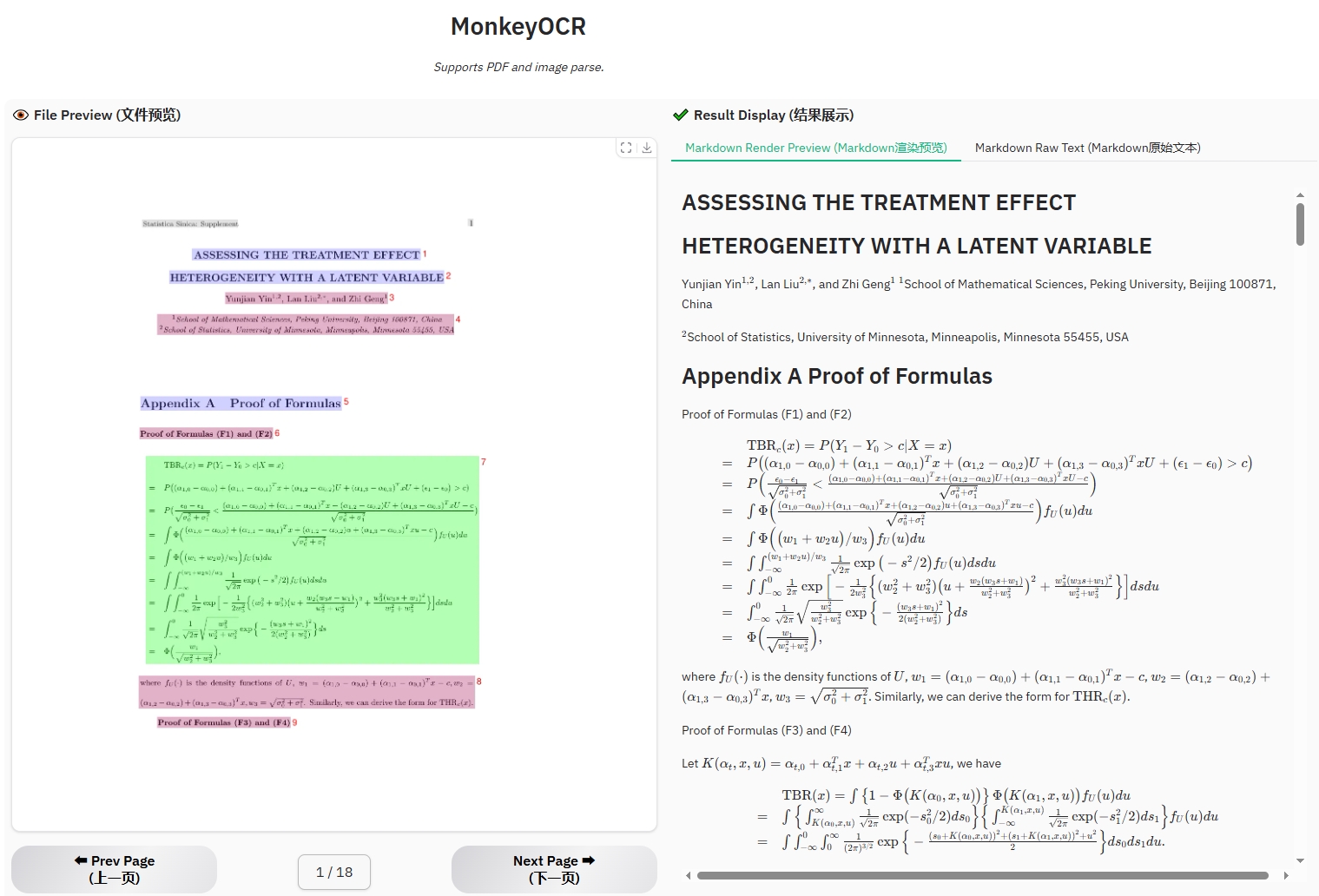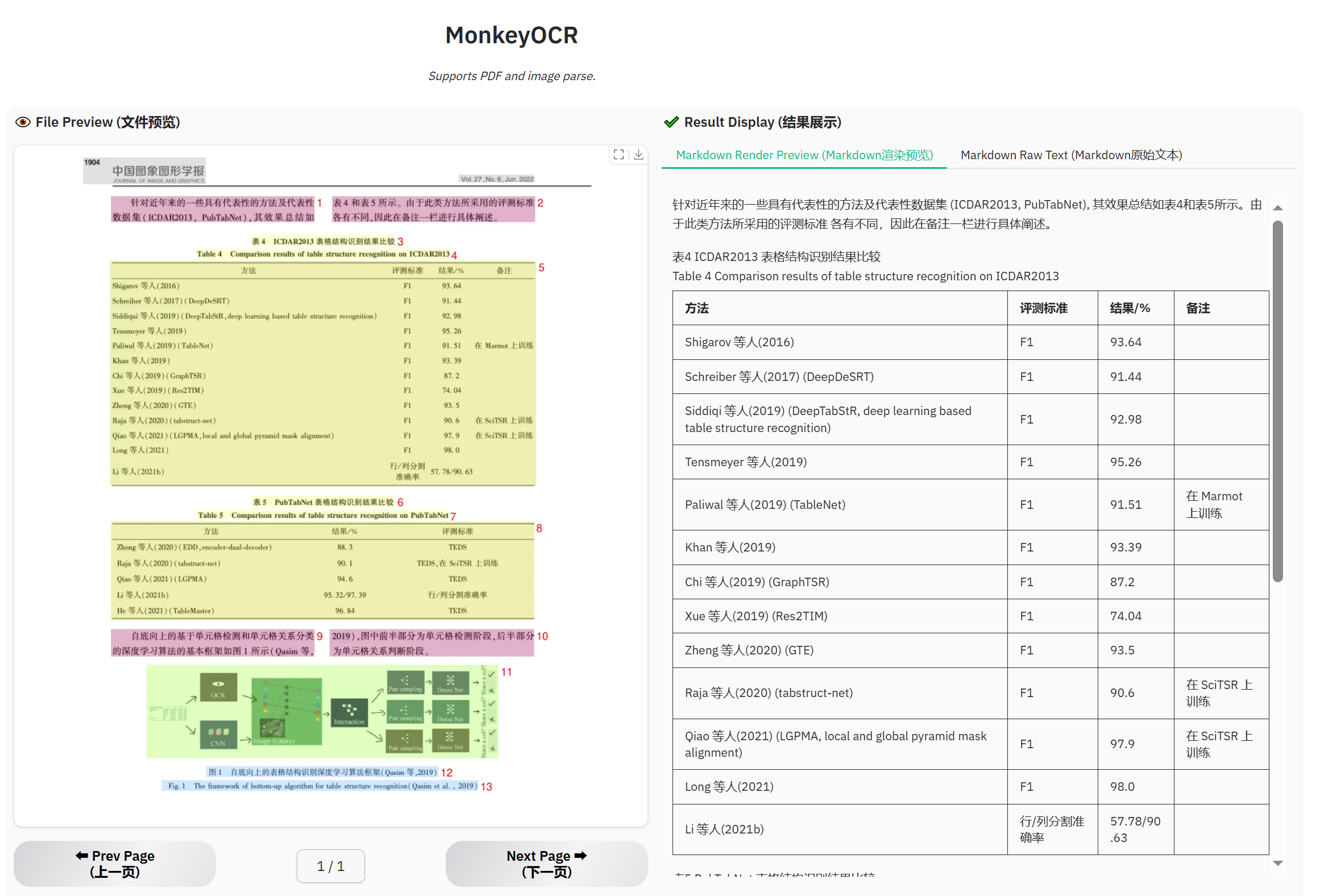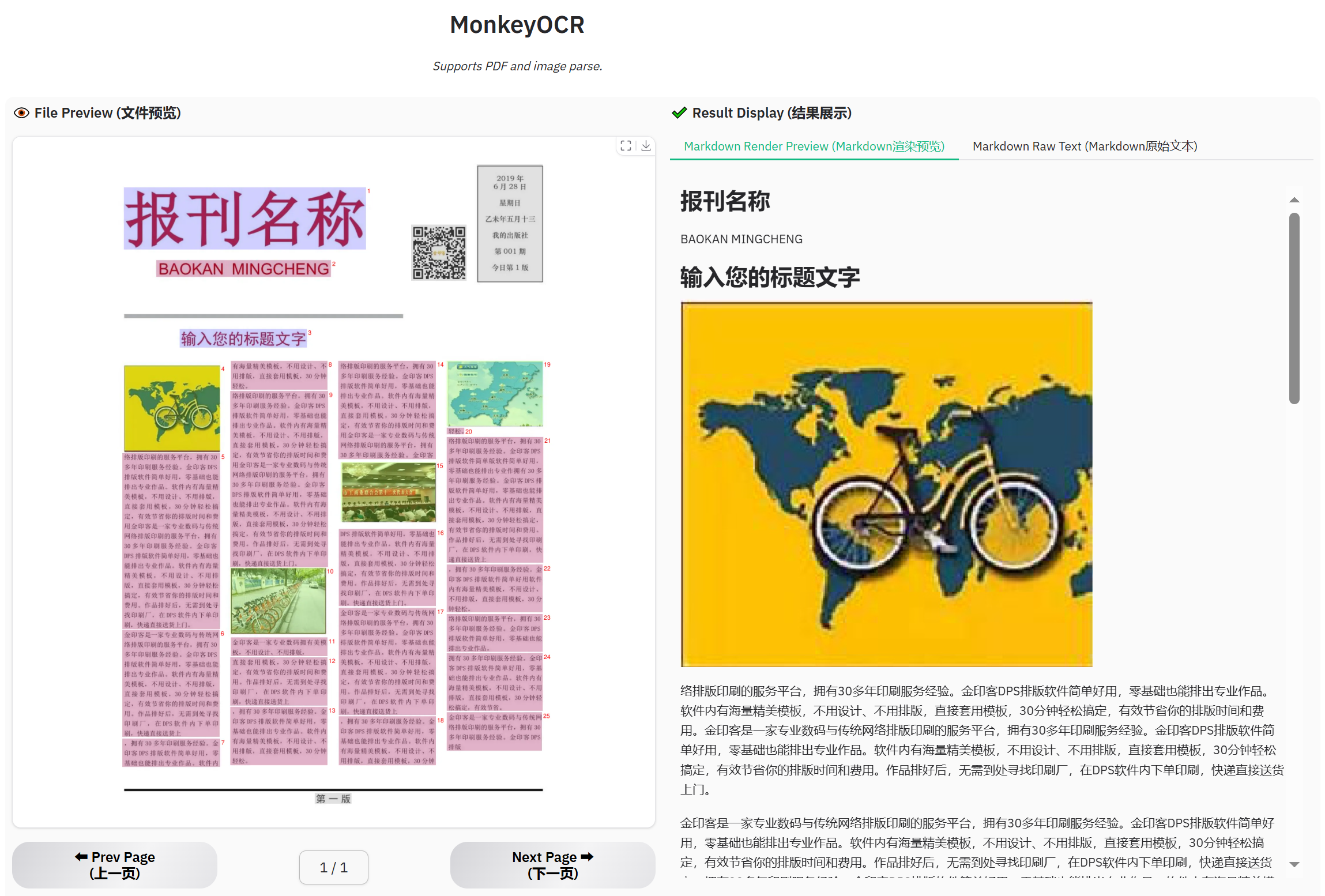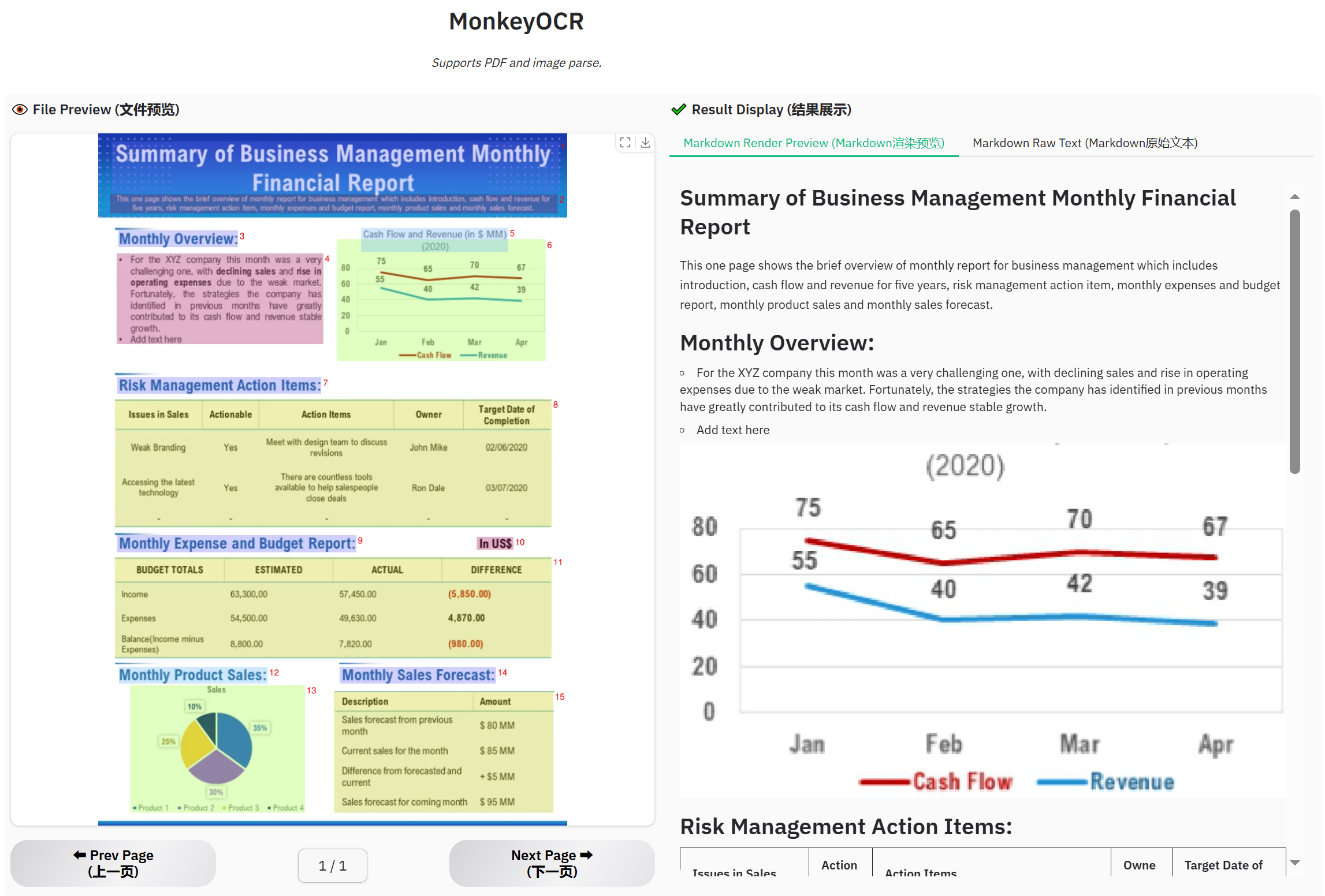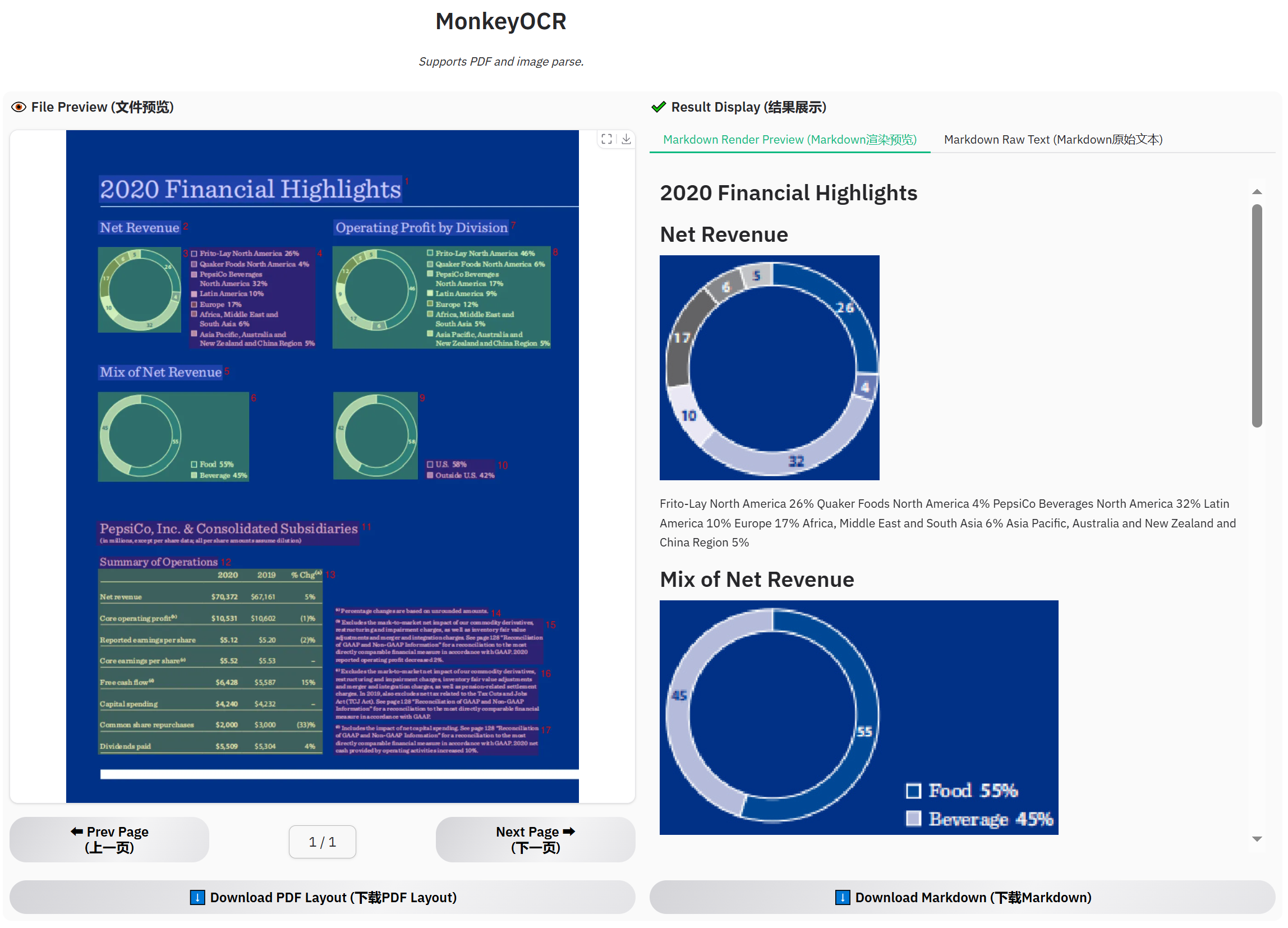MonkeyOCR: Document Parsing with a Structure-Recognition-Relation Triplet Paradigm
Zhang Li, Yuliang Liu, Qiang Liu, Zhiyin Ma, Ziyang Zhang, Shuo Zhang, Zidun Guo, Jiarui Zhang, Xinyu Wang, Xiang Bai





MonkeyOCR adopts a Structure-Recognition-Relation (SRR) triplet paradigm, which simplifies the multi-tool pipeline of modular approaches while avoiding the inefficiency of using large multimodal models for full-page document processing.
- MonkeyOCR-pro-1.2B surpasses MonkeyOCR-3B by 7.4% on Chinese documents.
- MonkeyOCR-pro-1.2B delivers approximately a 39% speed improvement over MonkeyOCR-pro-3B, with approximately 1.6% drop in performance.
- On olmOCR-Bench, MonkeyOCR-pro-1.2B outperforms Nanonets-OCR-3B by 7.3%.
- On OmniDocBench, MonkeyOCR-pro-3B achieves the best overall performance on both English and Chinese documents, outperforming even closed-source and extra-large open-source VLMs such as Gemini 2.0-Flash, Gemini 2.5-Pro, Qwen2.5-VL-72B, GPT-4o, and InternVL3-78B.
See detailed results below.
Inference Speed (Pages/s) on Different GPUs and PDF Page Counts
| Model | GPU | 50 Pages | 100 Pages | 300 Pages | 500 Pages | 1000 Pages |
|---|---|---|---|---|---|---|
| MonkeyOCR-pro-3B | A6000 | 0.572 | 0.583 | 0.605 | 0.593 | 0.597 |
| MonkeyOCR-pro-1.2B | A6000 | 0.799 | 0.790 | 0.806 | 0.812 | 0.807 |
2025.07.10🚀 We’re excited to release MonkeyOCR-pro-1.2B, — a leaner and faster version model that outperforms our previous 3B version in accuracy, speed, and efficiency.2025.06.12🚀 The model’s trending on Hugging Face. Thanks for the love!2025.06.05🚀 We release MonkeyOCR, an English and Chinese documents parsing model.
See the installation guide to set up your environment.
Download our model from Huggingface.
pip install huggingface_hub
python tools/download_model.py -n MonkeyOCR-pro-1.2B # MonkeyOCRYou can also download our model from ModelScope.
pip install modelscope
python tools/download_model.py -t modelscope -n MonkeyOCR-pro-1.2B # MonkeyOCRYou can parse a file or a directory containing PDFs or images using the following commands:
# Replace input_path with the path to a PDF or image or directory
# End-to-end parsing
python parse.py input_path
# Parse files in a dir with specific group page num
python parse.py input_path -g 20
# Single-task recognition (outputs markdown only)
python parse.py input_path -t text/formula/table
# Parse PDFs in input_path and split results by pages
python parse.py input_path -s
# Specify output directory and model config file
python parse.py input_path -o ./output -c config.yamlMore usage examples
# Single file processing
python parse.py input.pdf # Parse single PDF file
python parse.py input.pdf -o ./output # Parse with custom output dir
python parse.py input.pdf -s # Parse PDF with page splitting
python parse.py image.jpg # Parse single image file
# Single task recognition
python parse.py image.jpg -t text # Text recognition from image
python parse.py image.jpg -t formula # Formula recognition from image
python parse.py image.jpg -t table # Table recognition from image
python parse.py document.pdf -t text # Text recognition from all PDF pages
# Folder processing (all files individually)
python parse.py /path/to/folder # Parse all files in folder
python parse.py /path/to/folder -s # Parse with page splitting
python parse.py /path/to/folder -t text # Single task recognition for all files
# Multi-file grouping (batch processing by page count)
python parse.py /path/to/folder -g 5 # Group files with max 5 total pages
python parse.py /path/to/folder -g 10 -s # Group files with page splitting
python parse.py /path/to/folder -g 8 -t text # Group files for single task recognition
# Advanced configurations
python parse.py input.pdf -c model_configs.yaml # Custom model configuration
python parse.py /path/to/folder -g 15 -s -o ./out # Group files, split pages, custom output
python parse.py input.pdf --pred-abandon # Enable predicting abandon elementsTip
For Chinese scenarios, or cases where text, tables, etc. are mistakenly recognized as images, you can try using the following structure detection model: layout_zh.pt.
(If the model is not found in model_weight/Structure/, you can download it manually.)
To use this model, update the configuration file model_configs.yaml as follows:
doclayout_yolo: Structure/layout_zh.ptWe have added support for the PP-DocLayout_plus-L, which offers improved performance over doclayout_yolo. MonkeyOCR-pro-3B and MonkeyOCR-pro-1.2B utilized PP-DocLayout_plus-L for evaluation. Please refer to the Usage Guide.
To use this model, please update the configuration file model_configs.yaml as follows:
model: PP-DocLayout_plus-LMonkeyOCR generates three types of output files:
- Processed Markdown File (
your.md): The final parsed document content in markdown format, containing text, formulas, tables, and other structured elements. - Layout Results (
your_layout.pdf): The layout results drawed on origin PDF. - Intermediate Block Results (
your_middle.json): A JSON file containing detailed information about all detected blocks, including:- Block coordinates and positions
- Block content and type information
- Relationship information between blocks
These files provide both the final formatted output and detailed intermediate results for further analysis or processing.
# Start demo
python demo/demo_gradio.pyYou can start the MonkeyOCR FastAPI service with the following command:
uvicorn api.main:app --port 8000Once the API service is running, you can access the API documentation at http://localhost:8000/docs to explore available endpoints.
Tip
To improve API concurrency performance, consider configuring the inference backend as lmdeploy_queue or vllm_queue.
-
Navigate to the
dockerdirectory:cd docker -
Prerequisite: Ensure NVIDIA GPU support is available in Docker (via
nvidia-docker2). If GPU support is not enabled, run the following to set up the environment:bash env.sh
-
Build the Docker image:
docker compose build monkeyocr
Important
If your GPU is from the 30/40-series, V100, or similar, please build the patched Docker image for LMDeploy compatibility:
docker compose build monkeyocr-fixOtherwise, you may encounter the following error: triton.runtime.errors.OutOfResources: out of resource: shared memory
-
Run the container with the Gradio demo (accessible on port 7860):
docker compose up monkeyocr-demo
Alternatively, start an interactive development environment:
docker compose run --rm monkeyocr-dev
-
Run the FastAPI service (accessible on port 7861):
docker compose up monkeyocr-api
Once the API service is running, you can access the API documentation at http://localhost:7861/docs to explore available endpoints.
See the Windows Support Guide for details.
This model can be quantized using AWQ. Follow the instructions in the Quantization guide.
Here are the evaluation results of our model on OmniDocBench. MonkeyOCR-3B uses DocLayoutYOLO as the structure detection model, while MonkeyOCR-3B* uses our trained structure detection model with improved Chinese performance.
| Model Type |
Methods | OverallEdit↓ | TextEdit↓ | FormulaEdit↓ | TableTEDS↑ | TableEdit↓ | Read OrderEdit↓ | ||||||
|---|---|---|---|---|---|---|---|---|---|---|---|---|---|
| EN | ZH | EN | ZH | EN | ZH | EN | ZH | EN | ZH | EN | ZH | ||
| Pipeline Tools |
MinerU | 0.150 | 0.357 | 0.061 | 0.215 | 0.278 | 0.577 | 78.6 | 62.1 | 0.180 | 0.344 | 0.079 | 0.292 |
| Marker | 0.336 | 0.556 | 0.080 | 0.315 | 0.530 | 0.883 | 67.6 | 49.2 | 0.619 | 0.685 | 0.114 | 0.340 | |
| Mathpix | 0.191 | 0.365 | 0.105 | 0.384 | 0.306 | 0.454 | 77.0 | 67.1 | 0.243 | 0.320 | 0.108 | 0.304 | |
| Docling | 0.589 | 0.909 | 0.416 | 0.987 | 0.999 | 1 | 61.3 | 25.0 | 0.627 | 0.810 | 0.313 | 0.837 | |
| Pix2Text | 0.320 | 0.528 | 0.138 | 0.356 | 0.276 | 0.611 | 73.6 | 66.2 | 0.584 | 0.645 | 0.281 | 0.499 | |
| Unstructured | 0.586 | 0.716 | 0.198 | 0.481 | 0.999 | 1 | 0 | 0.06 | 1 | 0.998 | 0.145 | 0.387 | |
| OpenParse | 0.646 | 0.814 | 0.681 | 0.974 | 0.996 | 1 | 64.8 | 27.5 | 0.284 | 0.639 | 0.595 | 0.641 | |
| PPStruct-V3 | 0.145 | 0.206 | 0.058 | 0.088 | 0.295 | 0.535 | - | - | 0.159 | 0.109 | 0.069 | 0.091 | |
| Expert VLMs |
GOT-OCR | 0.287 | 0.411 | 0.189 | 0.315 | 0.360 | 0.528 | 53.2 | 47.2 | 0.459 | 0.520 | 0.141 | 0.280 |
| Nougat | 0.452 | 0.973 | 0.365 | 0.998 | 0.488 | 0.941 | 39.9 | 0 | 0.572 | 1.000 | 0.382 | 0.954 | |
| Mistral OCR | 0.268 | 0.439 | 0.072 | 0.325 | 0.318 | 0.495 | 75.8 | 63.6 | 0.600 | 0.650 | 0.083 | 0.284 | |
| OLMOCR-sglang | 0.326 | 0.469 | 0.097 | 0.293 | 0.455 | 0.655 | 68.1 | 61.3 | 0.608 | 0.652 | 0.145 | 0.277 | |
| SmolDocling-256M | 0.493 | 0.816 | 0.262 | 0.838 | 0.753 | 0.997 | 44.9 | 16.5 | 0.729 | 0.907 | 0.227 | 0.522 | |
| Dolphin | 0.206 | 0.306 | 0.107 | 0.197 | 0.447 | 0.580 | 77.3 | 67.2 | 0.180 | 0.285 | 0.091 | 0.162 | |
| Mineru2 | 0.139 | 0.240 | 0.047 | 0.109 | 0.297 | 0.536 | 82.5 | 79.0 | 0.141 | 0.195 | 0.069 | 0.118 | |
| General VLMs |
GPT4o | 0.233 | 0.399 | 0.144 | 0.409 | 0.425 | 0.606 | 72.0 | 62.9 | 0.234 | 0.329 | 0.128 | 0.251 |
| Qwen2.5-VL-7B | 0.312 | 0.406 | 0.157 | 0.228 | 0.351 | 0.574 | 76.4 | 72.2 | 0.588 | 0.619 | 0.149 | 0.203 | |
| InternVL3-8B | 0.314 | 0.383 | 0.134 | 0.218 | 0.417 | 0.563 | 66.1 | 73.1 | 0.586 | 0.564 | 0.118 | 0.186 | |
| Mix | MonkeyOCR-3B [Weight] | 0.140 | 0.297 | 0.058 | 0.185 | 0.238 | 0.506 | 80.2 | 77.7 | 0.170 | 0.253 | 0.093 | 0.244 |
| MonkeyOCR-3B* [Weight] | 0.154 | 0.277 | 0.073 | 0.134 | 0.255 | 0.529 | 78.2 | 76.2 | 0.182 | 0.262 | 0.105 | 0.183 | |
| MonkeyOCR-pro-3B [Demo] | 0.138 | 0.206 | 0.067 | 0.107 | 0.246 | 0.421 | 81.5 | 87.5 | 0.139 | 0.111 | 0.100 | 0.185 | |
| MonkeyOCR-pro-1.2B [Weight] | 0.153 | 0.223 | 0.066 | 0.123 | 0.272 | 0.449 | 76.5 | 83.7 | 0.176 | 0.131 | 0.097 | 0.187 | |
| Model Type |
Models | Book | Slides | Financial Report |
Textbook | Exam Paper |
Magazine | Academic Papers |
Notes | Newspaper | Overall |
|---|---|---|---|---|---|---|---|---|---|---|---|
| Pipeline Tools |
MinerU | 0.055 | 0.124 | 0.033 | 0.102 | 0.159 | 0.072 | 0.025 | 0.984 | 0.171 | 0.206 |
| Marker | 0.074 | 0.340 | 0.089 | 0.319 | 0.452 | 0.153 | 0.059 | 0.651 | 0.192 | 0.274 | |
| Mathpix | 0.131 | 0.220 | 0.202 | 0.216 | 0.278 | 0.147 | 0.091 | 0.634 | 0.690 | 0.300 | |
| Expert VLMs |
GOT-OCR | 0.111 | 0.222 | 0.067 | 0.132 | 0.204 | 0.198 | 0.179 | 0.388 | 0.771 | 0.267 |
| Nougat | 0.734 | 0.958 | 1.000 | 0.820 | 0.930 | 0.830 | 0.214 | 0.991 | 0.871 | 0.806 | |
| Dolphin | 0.091 | 0.131 | 0.057 | 0.146 | 0.231 | 0.121 | 0.074 | 0.363 | 0.307 | 0.177 | |
| General VLMs |
GPT4o | 0.157 | 0.163 | 0.348 | 0.187 | 0.281 | 0.173 | 0.146 | 0.607 | 0.751 | 0.316 |
| Qwen2.5-VL-7B | 0.148 | 0.053 | 0.111 | 0.137 | 0.189 | 0.117 | 0.134 | 0.204 | 0.706 | 0.205 | |
| InternVL3-8B | 0.163 | 0.056 | 0.107 | 0.109 | 0.129 | 0.100 | 0.159 | 0.150 | 0.681 | 0.188 | |
| Mix | MonkeyOCR-3B [Weight] | 0.046 | 0.120 | 0.024 | 0.100 | 0.129 | 0.086 | 0.024 | 0.643 | 0.131 | 0.155 |
| MonkeyOCR-3B* [Weight] | 0.054 | 0.203 | 0.038 | 0.112 | 0.138 | 0.111 | 0.032 | 0.194 | 0.136 | 0.120 | |
| MonkeyOCR-pro-3B [Demo] | 0.084 | 0.129 | 0.060 | 0.090 | 0.107 | 0.073 | 0.050 | 0.171 | 0.107 | 0.100 | |
| MonkeyOCR-pro-1.2B [Weight] | 0.087 | 0.142 | 0.059 | 0.093 | 0.115 | 0.085 | 0.045 | 0.226 | 0.122 | 0.112 |
| Model | ArXiv | Old Scans Math |
Tables | Old Scans | Headers and Footers |
Multi column |
Long Tiny Text |
Base | Overall |
|---|---|---|---|---|---|---|---|---|---|
| GOT OCR | 52.7 | 52.0 | 0.2 | 22.1 | 93.6 | 42.0 | 29.9 | 94.0 | 48.3 ± 1.1 |
| Marker | 76.0 | 57.9 | 57.6 | 27.8 | 84.9 | 72.9 | 84.6 | 99.1 | 70.1 ± 1.1 |
| MinerU | 75.4 | 47.4 | 60.9 | 17.3 | 96.6 | 59.0 | 39.1 | 96.6 | 61.5 ± 1.1 |
| Mistral OCR | 77.2 | 67.5 | 60.6 | 29.3 | 93.6 | 71.3 | 77.1 | 99.4 | 72.0 ± 1.1 |
| Nanonets OCR | 67.0 | 68.6 | 77.7 | 39.5 | 40.7 | 69.9 | 53.4 | 99.3 | 64.5 ± 1.1 |
| GPT-4o (No Anchor) |
51.5 | 75.5 | 69.1 | 40.9 | 94.2 | 68.9 | 54.1 | 96.7 | 68.9 ± 1.1 |
| GPT-4o (Anchored) |
53.5 | 74.5 | 70.0 | 40.7 | 93.8 | 69.3 | 60.6 | 96.8 | 69.9 ± 1.1 |
| Gemini Flash 2 (No Anchor) |
32.1 | 56.3 | 61.4 | 27.8 | 48.0 | 58.7 | 84.4 | 94.0 | 57.8 ± 1.1 |
| Gemini Flash 2 (Anchored) |
54.5 | 56.1 | 72.1 | 34.2 | 64.7 | 61.5 | 71.5 | 95.6 | 63.8 ± 1.2 |
| Qwen 2 VL (No Anchor) |
19.7 | 31.7 | 24.2 | 17.1 | 88.9 | 8.3 | 6.8 | 55.5 | 31.5 ± 0.9 |
| Qwen 2.5 VL (No Anchor) |
63.1 | 65.7 | 67.3 | 38.6 | 73.6 | 68.3 | 49.1 | 98.3 | 65.5 ± 1.2 |
| olmOCR v0.1.75 (No Anchor) |
71.5 | 71.4 | 71.4 | 42.8 | 94.1 | 77.7 | 71.0 | 97.8 | 74.7 ± 1.1 |
| olmOCR v0.1.75 (Anchored) |
74.9 | 71.2 | 71.0 | 42.2 | 94.5 | 78.3 | 73.3 | 98.3 | 75.5 ± 1.0 |
| MonkeyOCR-pro-3B [Demo] | 83.8 | 68.8 | 74.6 | 36.1 | 91.2 | 76.6 | 80.1 | 95.3 | 75.8 ± 1.0 |
| MonkeyOCR-pro-1.2B [Weight] | 80.5 | 62.9 | 71.1 | 32.9 | 92.2 | 68.3 | 74.0 | 92.6 | 71.8 ± 1.1 |
Get a Quick Hands-On Experience with Our Demo: http://vlrlabmonkey.xyz:7685 (The latest model is available for selection)
Our demo is simple and easy to use:
- Upload a PDF or image.
- Click “Parse (解析)” to let the model perform structure detection, content recognition, and relationship prediction on the input document. The final output will be a markdown-formatted version of the document.
- Select a prompt and click “Test by prompt” to let the model perform content recognition on the image based on the selected prompt.
If you wish to refer to the baseline results published here, please use the following BibTeX entries:
@misc{li2025monkeyocrdocumentparsingstructurerecognitionrelation,
title={MonkeyOCR: Document Parsing with a Structure-Recognition-Relation Triplet Paradigm},
author={Zhang Li and Yuliang Liu and Qiang Liu and Zhiyin Ma and Ziyang Zhang and Shuo Zhang and Zidun Guo and Jiarui Zhang and Xinyu Wang and Xiang Bai},
year={2025},
eprint={2506.05218},
archivePrefix={arXiv},
primaryClass={cs.CV},
url={https://arxiv.org/abs/2506.05218},
}We would like to thank MinerU, DocLayout-YOLO, PyMuPDF, layoutreader, Qwen2.5-VL, LMDeploy, PP-StructureV3, PP-DocLayout_plus-L, MinerU 2.0, and InternVL3 for providing base code and models, as well as their contributions to this field. We also thank M6Doc, DocLayNet, CDLA, D4LA, DocGenome, PubTabNet, and UniMER-1M for providing valuable datasets. We also thank everyone who contributed to this open-source effort.
Currently, MonkeyOCR do not yet fully support for photographed text, handwritten content, Traditional Chinese characters, or multilingual text. We plan to consider adding support for these features in future public releases. Additionally, our model is deployed on a single GPU, so if too many users upload files at the same time, issues like “This application is currently busy” may occur. The processing time shown on the demo page does not reflect computation time alone—it also includes result uploading and other overhead. During periods of high traffic, this time may be longer. The inference speeds of MonkeyOCR, MinerU, and Qwen2.5 VL-7B were measured on an H800 GPU.
Please don’t hesitate to share your valuable feedback — it’s a key motivation that drives us to continuously improve our framework. Note: Our model is intended for academic research and non-commercial use only. If you are interested in faster (smaller) or stronger one, please contact us at [email protected] or [email protected].












